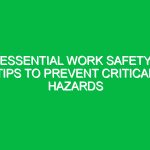Understanding Work at Height in the HSE Context
Work at height refers to any work undertaken where a person could fall a distance liable to cause personal injury. This can occur at various heights, from a simple step ladder to the upper floors of a building. The relevance of work at height within the Health, Safety, and Environment (HSE) domain is profound, as falls from height remain one of the leading causes of workplace injuries and fatalities. In fact, according to the Health and Safety Executive in the UK, a significant percentage of workplace fatalities are due to falls from height. Thus, ensuring Safety while working at heights is not just a legal requirement; it is a moral obligation to protect workers and promote a culture of safety.
In this article, we will explore essential safety tips for work at height, discuss Best Practices, outline potential Hazards, and provide insights into Regulations and Standards that govern this critical area.
Key Aspects of Work at Height Safety
1. Risk Assessment and Planning
Before starting any work at height, a thorough risk assessment is crucial. This assessment should identify potential Hazards, evaluate the risks associated with those hazards, and determine the necessary Control Measures to mitigate those risks. Key elements of a risk assessment include:
- Identifying Hazards: Look for potential risks, such as unstable surfaces or inadequate Fall Protection.
- Evaluating Risks: Consider the likelihood of a fall and the potential consequences.
- Implementing Control Measures: Decide on the best approach to minimize risks, such as using guardrails or Personal Protective Equipment (PPE).
A personal anecdote illustrates this point well. In a construction project I was involved in, our team conducted a detailed risk assessment before installing scaffolding. This foresight allowed us to identify a weak point in the ground that could have caused a serious accident, and we were able to reinforce it before work commenced.
2. Proper Training and Competency
Training is a fundamental component of any work at height safety strategy. Workers must be trained not only in how to use equipment safely but also in recognizing the hazards associated with Working at Height. Training should cover:
- Safe Use of Equipment: How to properly use ladders, scaffolds, harnesses, and other fall protection devices.
- Emergency Procedures: What to do in the event of a fall or other emergency.
- Health and Safety Regulations: Understanding the legal requirements surrounding work at height.
For instance, a construction site I visited had implemented a comprehensive training program that included both practical and theoretical components. As a result, workers were not only equipped with the necessary skills but also developed a strong safety mindset, significantly reducing the incidence of near-misses.
3. Selecting Appropriate Equipment
Choosing the right equipment is vital for maintaining safety while working at height. This includes ladders, scaffolding, and harnesses. Here are some guidelines:
- Ladders: Ensure ladders are in good condition and appropriate for the task. Use the right type of ladder, whether it be a step ladder for low heights or an extension ladder for higher levels.
- Scaffolding: Use scaffolding that is properly erected and inspected. Ensure it is stable and capable of supporting the intended load.
- Personal Protective Equipment (PPE): Always wear appropriate PPE, including helmets, harnesses, and non-slip footwear.
An example that stands out in my mind was a roofing project where the team used a combination of scaffolding and harnesses. The scaffold was inspected daily, and the workers were all equipped with safety harnesses, leading to a zero-incident rate throughout the duration of the project.
4. Establishing Safe Work Practices
Implementing safe work practices is essential for minimizing risks associated with working at height. Here are some Best Practices:
- Maintain a Safe Distance: Keep a safe distance from the edge of roofs or other high surfaces.
- Use Fall Protection Systems: Employ guardrails, safety nets, and personal fall arrest systems as necessary.
- Regular Inspections: Conduct regular inspections of equipment and work areas to ensure safety standards are maintained.
One of the most effective practices I’ve observed was during a Maintenance job on a high-rise building where the team established a “Safety First” mantra. They consistently conducted safety briefings before starting work and ensured that all team members were aware of their roles in maintaining a safe work environment.
Potential Hazards and Safety Considerations
Understanding the potential hazards associated with work at height is critical for preventing accidents. Some common hazards include:
- Falls: The most obvious hazard, falls can occur due to improper use of equipment or lack of fall protection.
- Falling Objects: Tools or materials can fall from heights, posing risks to workers below.
- Weather Conditions: Wind, rain, or snow can significantly increase the risk of falls and equipment failure.
To mitigate these hazards, consider implementing a comprehensive safety management system that includes regular training sessions, safety audits, and emergency response drills. This proactive approach fosters a culture of safety, encouraging workers to prioritize their well-being.
Regulations and Standards Governing Work at Height
Numerous regulations and standards govern work at height, aimed at ensuring the safety of workers. In the UK, the Work at Height Regulations (WAHR) 2005 is a key piece of legislation that outlines the responsibilities of employers and employees regarding working at height. Here are some essential points from the regulations:
- Planning: Work at height must be properly planned, supervised, and carried out by competent individuals.
- Risk Assessment: Employers must conduct risk assessments and implement necessary control measures.
- Equipment Standards: All equipment used for work at height must meet safety standards and be maintained regularly.
Compliance with these regulations is not merely a legal obligation; it is crucial for fostering a safe work environment. In my experience, sites that adhere to these regulations not only protect their workers but also enhance their reputation and productivity.
Conclusion
In conclusion, ensuring safety while working at height is a multifaceted endeavor that requires careful planning, training, and adherence to regulations. By understanding the risks, implementing Safe Practices, and fostering a culture of safety, organizations can significantly reduce the likelihood of accidents and injuries.
As we’ve discussed, the consequences of neglecting Safety Measures in work at height can be severe. It is imperative for employers and workers alike to prioritize safety, not only for legal compliance but also for the well-being of all individuals involved. By doing so, we contribute to a safer, healthier, and more sustainable work environment.
Let us remain vigilant and proactive, ensuring that every worker returns home safely at the end of the day.


